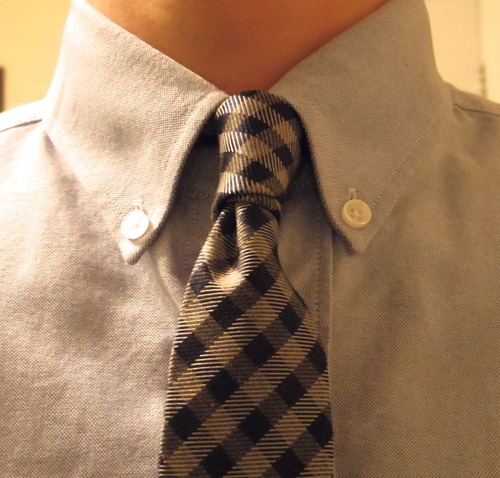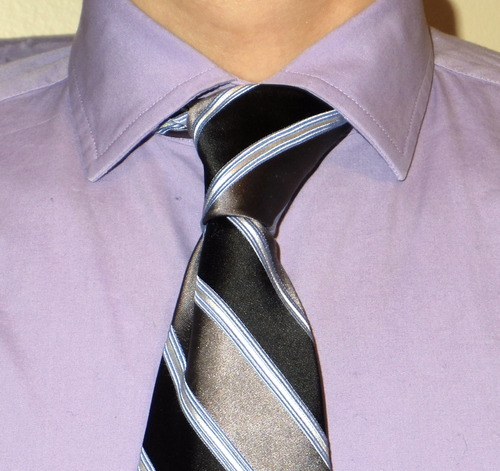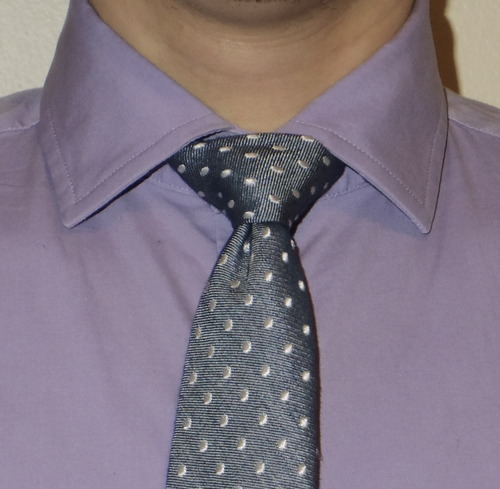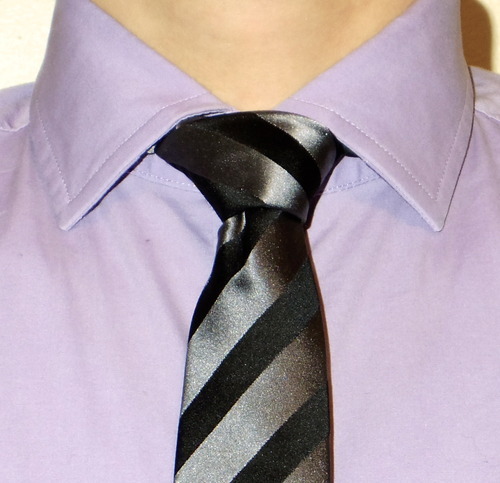As promised, I’m going to keep delving into the wonderful world of the necktie. I’ve written about tie knots before, but this post goes into more detail on all the knots that are available and when to use them. Tie-A-Tie.net covers all the instructional bases much better than I’d be able to, so I will refrain from trying to repeat the innumerable tutorials that are already out there, and this post will be less of a ‘how-to and more of a ‘how to do it right.’
So what are your options?
The first (and most versatile) knot you should know is the Four-In-Hand. I know I said there is no ‘go-to’ knot, but this one comes close. This knot is on the smaller side and markedly asymmetric. With the growing trend in menswear to try to look dapper without being over-polished, stylish without looking too damn perfectly put together, this knot is a great way to tavoid that ‘perfect-triangle,’ Dorito-lookin tie knot that can make you look like you just rolled off a factory line of Donald Trumps, cheesy politicians and used car salesmen. The small nature of this knot makes it perfect for point-collar shirts and button-down collars. It also is one of the few knots that looks naturally proportional with a skinnier tie. Like I said, I’m a big fan of this one and use it almost every day. The biggest trouble I run into with this knot is that it doesn’t take up much of the tie length, and I am often left with a too-long-tie. The quick solution to this is to throw in one more loop and turn the knot into a Double Four-In Hand, a knot used extensively by some of the more fashion-forward Italian gentlemen, and one I have become a huge fan of lately. It adds some nice heft to lighter ties (such as cotton, linen, or thin twill), and comes out with a really nice looking knot that just hints at luxury. See below:

The next knot I would say you should know is the Double Windsor, more because it is a classic staple that a lot of other knots are based off of than because of any recommendation of mine to actually wear the thing. This is where you get that big triangle Dorito look I always complain about. However, the Double Windsor does have it’s place, mainly among power suits and super-spread collars. It’s a very in-your-face knot, often associated with Wall Street boys and Hollywood Agents (I think Ari of Entourage fame always wore a nice, big Double Windsor). Don’t even try this knot with a point collar, as either the shirt will swallow the knot, or the knot will push at your collar in a most unseemly way (see, somehow even writing about the Double Windsor makes me a little pompous, I apologize). I also apologize that this isn’t the greatest looking knot in the picture, but I rarely use this knot, so I’m not a pro. Deal with it:
My suggestion, if you want something with a bit more heft and formality than the Four-In Hand, would be to go for a Half-Windsor or a Shelby/Pratt knot. Both of these knots essentially take out a loop of the Double Windsor, simultaneously making it a bit smaller and more approachable while adding a touch of asymmetry to keep it interesting. These two (in my opinion) are pretty interchangable, but I’ve found the Half Windsor to work better with wider ties while the Shelby/Pratt gives you a nice wide knot on a skinny tie without looking silly. The Shelby/Pratt is my go-to when wearing a spread collar, as most of my ties are on the skinnier end. It’s also a slightly more formal knot, so I tend to wear it when I am dressing up for a special occaision. It can be a bit tricky at first, because it’s one of the few knots that requires you to start with your tie essentially ‘inside-out,’ but you get the hang of it after a few tries. Here is the Shelby:

And the Half Windsor:



And the Half Windsor:

After these four options, there are literally countless variations, many of which I can’t even tell the difference between, but these are the four basics that most other knots are derived from. Sit in front of a mirror and practice these until they are ingrained in your memory and you will be prepared for pretty much any occasion that calls for neckwear. And please, by all means, avoid those goddamn novelty knots.

No comments:
Post a Comment